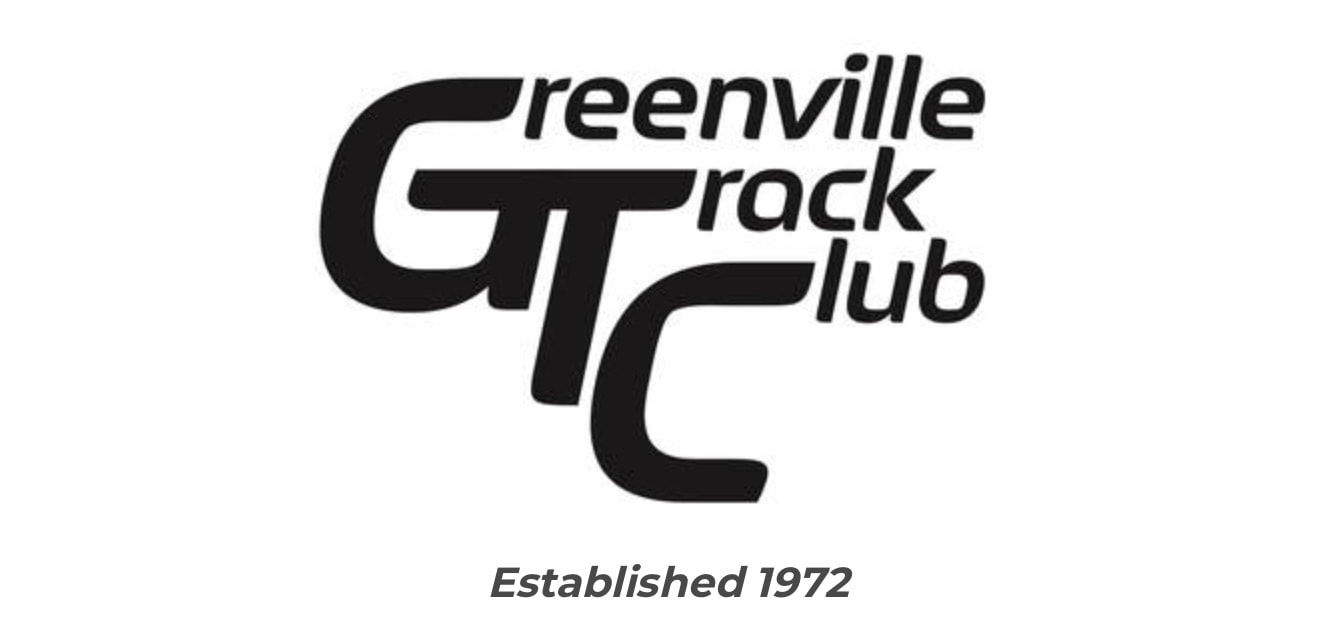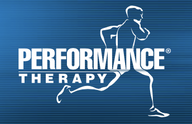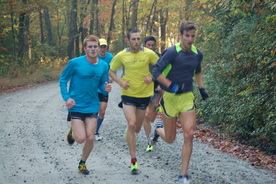 With appreciation to sage William Shakespeare, many times the most important question in a runner’s day is “to run, or not to run?” For over thirty years, I avowed to answer that thought with, “To run” of course. Consecutive days of running soon became weeks, then became months and soon became years. Over 11,200 days came and went and each one contained running. Mileage during that “running streak” totaled over 75,000 and would have continued except for a freak accident while taking care of yard work one day following a 60-minute run on Paris Mountain. Yes, that is a very long streak of not missing a day of running. However, there are others with longer streaks. An old acquaintance by the name of Mark Covert had a streak of 45 years, when he decided to end it in July of 2013. What I admired about Mark was that he wasn’t just someone who went out and jogged a mile as some “streakers” do. Covert was a highly competitive athlete and once placed 7th in the 1972 USA Olympic Marathon Trials and was the first runner to complete a marathon in a new brand of footwear named Nike. So running everyday must be good for you as a runner? Not so fast my friends. Although I was fortunate to have experienced a very memorable running streak of over 30 years, that would not have been the case if I had still had the desire to compete at a high level. Following a very good high school running career, but a modest collegiate experience while at Furman University, I relocated to Gainesville, FL, to join the Florida Track Club and their collection of post-collegiate runners--including Olympic marathon champion Frank Shorter and Olympians Marty Liquori and Dick Buerkle. While there, I learned to endure high mileage training consisting of weeks of 120-140 miles with no planned off days. If you missed a day of running it was usually due to injury. We even had a route around the airport in Atlanta so you could get in a run if you had an extensive layover when traveling. And then I became educated in the art of training smarter. As a studied for my post-graduate degrees in the areas of physiology of exercise and movement science, I gradually accepted the fact that an organism needs to recover from the stress applied in order to adapt and develop. Bill Bowerman, the famous coach at the University of Oregon, had used his philosophy of “hard” days followed by “easy” days of training to produce an amazing number of sub 4:00 milers as well as Kenny Moore, who later placed 4th in the 1972 Olympic marathon in Munich, Germany. Moore, who had incorporated very long runs, sometimes up to 30 miles, into is training regimen had previously earned the ire of Bowerman as an undergraduate at Oregon. Bowerman had “forced” Moore to reduce the mileage on his “easy” days to a mere 3 miles so that he could recover from his harder workout days. Counter-intuitive to what most runners want to believe, the “hard/easy” system produced many top performances. Running hard every day was not the answer and most likely became the problem. I had also witnessed the excellent performances of some of the European runners who had migrated to the United States to compete for various universities as NCAA athletes. To our dismay, some of them actually took complete days off from training following a very hard workout day. And many of them became NCAA champions. Soon I began to change my philosophy regarding training and the body’s response to stress. That continued to evolve over the years, but has been centered on optimizing each training cycle by including “recovery” and “regeneration” days. While our philosophy with our ASICS Greenville Track Club-ELITE athletes is centered around a group-training experience, we ensure individualization is promoted regarding recovery/regeneration days. We plan an “off” day into every micro-cycle (which may be 7 or 14 days in length). Many times that day may include some light running, but limited to an easy 30 minutes, or some alternative exercise such as aqua jogging, swimming or time on the ElliptiGO. We have found that not only is it okay to take a day off, but it is beneficial to our athlete’s development. However, it is our belief that the sequencing of training is vital and that is why we usually schedule our “off” day on Mondays, following our Sunday long run and before our Tuesday hard workout session. We will not consciously schedule a workout session the day following our long run, as we prefer 36-44 hours of recovery and adaptation following those extended efforts. We also schedule two other “easy” days within each 7-day micro-cycle or a total of six easy days within a 14-day cycle. These easy days usually consist of a 40-50 minute run followed by 45 minutes of ancillary work for strength, balance and flexibility. So each harder day is followed by an “easy” running day to recover, except for our Saturday sessions, which are followed by the regenerative long run. At the end of our macrocycle, following our targeted “goal’ race of the season, we schedule 3-5 days of non-running activity and recovery to recharge our bodies and freshen up for the next training cycles. So would I embark on a running streak if I had it to do over? Not if I had competitive goals. To reach those goals, it would be much more productive to incorporate some “off” days into the training cycles so that my body could recover and adapt to the stress applied and thus improve.
1 Comment
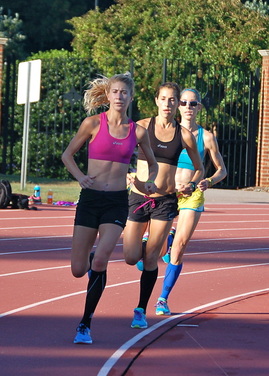 ASICS Greenville Track Club-ELITE ASICS Greenville Track Club-ELITE As professional running coaches, my wife and I are often asked about how many miles our athletes run each week. That would seem to warrant a fairly simple answer. However, we usually have to do some quick mental calculations to determine the appropriate answer. Why? Primarily because we plan our training using “time spent running” versus total distance run. In recent years, there have been quite a few other coaches also espousing the use of time versus distance for calculating training and total work values. It should be noted that we do use distances in planning our interval or repetition training sessions, but for the overall long, medium or easy run days, we just set a target time such as 2 hours, 80 minutes or maybe 40 minutes of running. For our weekly targets, we total minutes spent running. Our athletes averaged between 350 and 900 minutes per week, depending on their specific individual needs and strengths. If we desire to calculate miles per week, we just divide by a default such a 7:00 per mile or 4:20 per kilometer. This method is as old as the hills and became familiar to me during my days of training with the famous Florida Track Club. More recently, former University of Wisconsin coach (now with the Bowerman Track Club in Portland, OR) labeled this method “Badger Miles” when he used it with his Wisconsin Badger distance runners. For example: a 70-minute run would be 10 miles (70 / 7 = 10) even though the runner may have gone slower or faster (usually faster at their level). It usually averages out over the week. For some reason Americans like to measure things in miles. The majority of American runners time their runs and are tethered to “pace per mile” for their acceptance of whether their training session was successful or not. Ironically, the majority of running events are measured and run over metric distances: 100, 200, 400, 800, 1500, 5000, 10000 meters and are not easily divided by the imperial measures such as yards or miles. Yes, your GPS can easily calculate your pace per mile for a 10K, but it is easier to switch the unit value to Kilometers (Ks) and receive more frequent feedback of actual segment splits rather than the computed average. If you don’t have a GPS, dividing segments within the metric distances is much easier than in the imperial measurement system when running metric distances. For example: a 30-minute 10K is just 10 x 3:00 minutes for each K and a 40-minute 10K is just 4:00 minutes per K. Just for fun: mentally calculate the mile pace for either of those times (30:00 or 40:00 for 10K) in the next 15 seconds. Not very easy? Many runners still think that each lap of a standard outdoor track is one/quarter of a mile. And it almost is, but not quite. Our 400-meter ovals are just short of 440 yards and running four laps is about nine meters short of a mile. Close enough if you are only running one mile, but obviously as you run longer distances, the gap begins to grow. So, after many years of running and coaching, we definitely plan our timed-quality workouts using meters. Our brains have accepted the metric system. So what about minutes versus miles, or kilometers? As previously stated we target specific metric distances for interval or repetition workouts as we usually run such on either a 400-meter track or some other measured surface such as grass or asphalt. (You can find our GTC-ELITE athletes on Greenville’s Swamp Rabbit Trail on quite a few Tuesday mornings during the year.) But we use time, especially minutes, for the majority of our runs. For instance, our usual pre-workout warmup includes a 20-minute run instead of a 4K or 5K run. Even though each of our athletes may wish to run at their own pace and perceived effort for their warmup run, everyone starts and finishes at approximately the same time (20 minutes). If the target warmup was a specific distance, there would be discrepancies among the athletes and we would have to wait for some to complete the exact distance. But, most importantly, the human body does not have a pedometer to measure distances, but does have an internal clock at the cellular level, which computes time spent using a specific energy system. For example, when using the phosphogen energy system, there is enough energy to run 8-10 seconds. The body does not compute the distance covered, but the time it is working. The same holds true for the anaerobic energy system, which is utilized for work bouts under 120 seconds. If an athlete is running hard (above anaerobic threshold and above VO2 max) the muscles are energized by anaerobic systems. This philosophy of using time versus distance corresponds very favorably when incorporating the important “long run” into training programs. Many marathon programs prescribe a 20-mile run. However, we always target time since each of our athletes will most likely run at a slightly different pace. Some may cover 36 kilometers in their 120-minute (2-hour) run while another may only complete 30K. Even though there is a difference of 6K between the two athletes, each of them produced a positive training effect, respective to their current capability. And time, not distance, is even more important on our recovery days. We like our athletes to run easy and not force the pace to cover a prescribed distance. We usually cover from 30 to 45 minutes depending on our target for the week and what transpired on the previous workout or harder day. So the question may not actually be “minutes versus miles?” but more correctly “minutes versus kilometers?” But the answer according to our philosophy is that elapsed time trumps distance covered. So ladies and gentlemen “start your watches”. |
AuthorMike Caldwell is the Director and one of the coaches for ASICS Greenville Track Club-ELITE. For more on Mike please visit his page on this website. Archives
June 2020
Categories |
- News Blog
-
About Us
- Mission, etc.
- Our Four Pillars
- Our Maxims
- Contact Us
- Support Us
- Board of Directors
- Qualifying Standards
- FAQs
- Apply
- Olympic Trials Qualifiers
- NCAA Champions
- NCAA All Americans
- Club Records
- SC State Records
- Performance Lists
- Victories
- USA Road Championships
- Program Highlights >
- Community Involvement
- Legacy Running Camp
- Schedule
- Coaching & Training
- Laura Caldwell Fellowship
- Current Athletes
-
Alumni
- Wallace Campbell
- Calista Ariel
- Chass Armstrong
- Trent Binford-Walsh
- Ryan Bugler
- Chris Caldwell
- Josh Cashman
- Shawnee Carnett
- Frank DeVar
- Nicole DiMercurio
- Kate Dodds
- Dylan Doss
- Ricky Flynn
- Emily Forner
- Adam Freudenthal
- Dylan Hassett
- Mark Leininger
- Mackenzie Lowe
- Zach Mains
- Cristina McKnight
- Avery Martin
- Tyler Morse
- Joe Niemiec
- Alison Parris
- Victor Pataky
- Annie Rodenfels
- Ryan Root
- Kimberly Ruck
- Austin Steagall
- Carolyn Watson
- Chelsi Woodruff
- Blake Wysocki
- Pics & Vids
- Sponsors
- Greenville, etc
- Social Media
- News Blog
-
About Us
- Mission, etc.
- Our Four Pillars
- Our Maxims
- Contact Us
- Support Us
- Board of Directors
- Qualifying Standards
- FAQs
- Apply
- Olympic Trials Qualifiers
- NCAA Champions
- NCAA All Americans
- Club Records
- SC State Records
- Performance Lists
- Victories
- USA Road Championships
- Program Highlights >
- Community Involvement
- Legacy Running Camp
- Schedule
- Coaching & Training
- Laura Caldwell Fellowship
- Current Athletes
-
Alumni
- Wallace Campbell
- Calista Ariel
- Chass Armstrong
- Trent Binford-Walsh
- Ryan Bugler
- Chris Caldwell
- Josh Cashman
- Shawnee Carnett
- Frank DeVar
- Nicole DiMercurio
- Kate Dodds
- Dylan Doss
- Ricky Flynn
- Emily Forner
- Adam Freudenthal
- Dylan Hassett
- Mark Leininger
- Mackenzie Lowe
- Zach Mains
- Cristina McKnight
- Avery Martin
- Tyler Morse
- Joe Niemiec
- Alison Parris
- Victor Pataky
- Annie Rodenfels
- Ryan Root
- Kimberly Ruck
- Austin Steagall
- Carolyn Watson
- Chelsi Woodruff
- Blake Wysocki
- Pics & Vids
- Sponsors
- Greenville, etc
- Social Media
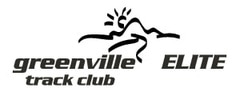

 RSS Feed
RSS Feed
